Abstract
WiFi (wireless fidelity) signals, renowned for their extensive coverage, absence of electromagnetic pollution, and robust penetration capabilities, are exceptionally well suited for serving as an external radiation source in target detection and environmental perception applications. The current paper delves into the viability of leveraging WiFi signals for the purpose of human behavior recognition. Initially, the paper elucidates the distinctive attributes of typical WiFi signals. Subsequently, it formulates a parametric mathematical model to represent human walking, encompassing an analysis of several prevalent translational and rotational motions. Building upon this human body kinematic model, this study generates echo data corresponding to human walking patterns. A comprehensive simulation, analysis, and validation of the micro-Doppler characteristics associated with various body parts and the whole body in motion are then conducted. The findings from these simulations and analyses affirm the efficacy of the proposed methodology.
1. Introduction
In recent years, the swift advancement of wireless local area networks (WLANs) has opened up new possibilities in passive detection technologies, particularly those utilizing WiFi (wireless fidelity) signals. Modern society frequently faces emergencies such as earthquakes, fires, mine collapses, hijackings, kidnappings, terrorist activities, and more, which pose significant threats to public safety and personal property. As a non-contact proximity detection technique, through-wall detection has found extensive application in addressing these challenges. The utilization of WiFi signals as a non-cooperative, opportunistic illumination source for through-wall detection offers several inherent advantages [1], which are elaborated as follows.
Firstly, WLANs have achieved widespread deployment in China, particularly in public venues such as shopping malls, critical offices, transportation terminals, residential areas, hotels, and other lodging facilities, ensuring comprehensive signal coverage. This extensive coverage provides a solid foundation for reliable detection in various scenarios. Secondly, WiFi signals are readily accessible via wireless routers, with densely distributed access points facilitating the establishment of a detection network and enabling easy expansion of the detection range. The ease of access and deployment of WiFi signals allows for a flexible and scalable detection system that can be adapted to different environments and requirements. Thirdly, WiFi signals operating in the 2.4/5 GHz frequency bands provide high distance resolution and exhibit strong penetration capabilities through buildings, eliminating detection blind zones. This enables effective detection even in complex indoor environments with multiple walls and obstacles. Lastly, passive detection based on WiFi signals also boasts advantages, such as low power consumption, excellent concealment, and reduced system costs. These characteristics make WiFi-based detection systems more energy-efficient and cost-effective compared to traditional active detection methods.
In previous studies [2], an in-depth analysis of signal reflection modes and characteristics within indoor environments is described. This study establishes a time difference in arrival (TDOA) model tailored for WiFi radiation source localization, addressing the critical challenge of real-time indoor radiation source position acquisition—a pioneering step in the field application of WiFi as a radiation source. Furthermore, the literature [3,4] delves into the WiFi signal format from a detection application perspective. These works investigate the issues associated with undesirable WiFi signal waveforms and significant direct wave/multipath interference. By leveraging WiFi signals as a radiation source, studies have successfully achieved the reliable detection of moving targets, thereby fulfilling the objective of monitoring indoor moving targets. Collectively, these investigations demonstrate that, following WiFi signal shaping and the suppression of direct waves and clutter, the detection of moving humans based on typical WiFi signals is feasible in indoor environments characterized by high clutter.
In the evolution of human behavior recognition research, numerous methodologies have been proposed [5,6,7]; however, the majority of these rely heavily on video surveillance systems. The visual perception of human actions can be susceptible to factors such as distance, variations in lighting conditions, and changes in attire. In contrast, utilizing WiFi as a radiation source offers the advantages of continuous operation, day and night, along with the capability to penetrate walls. This paper delves deeper into the realm of human behavior recognition through WiFi signal-based human detection.
Indeed, the motion of body parts, such as arm and leg swings during walking, induces modulations in the echo signals. These subtle movements manifest as corresponding Doppler frequency distributions, referred to as micro-Doppler characteristics. These characteristics serve as a reflection of the kinematic properties of the human body and offer a distinctive means for identifying human behavioral modalities. By conducting an extensive analysis of the diverse attributes of this unique feature, valuable information pertaining to human behavior can be extracted. This, in turn, facilitates the discrimination or qualitative analysis of human behavioral patterns [8,9,10].
2. Materials and Methods
2.1. Wi-Fi Signal Characteristics
Wireless local area networks (WLANs) have experienced rapid development, prompting the IEEE working group to define a series of applications for WLAN technology, encompassed within the IEEE 802.11 family of standards, including 802.11a/b/g/n and others [8]. Among these, 802.11g has emerged as the most widely adopted standard, utilizing Orthogonal Frequency Division Multiplexing (OFDM) modulation. The IEEE 802.11g working group specified four physical layer technologies: the Direct Spread Spectrum (DSSS) modulation technique with Complementary Code Keying (CCK), OFDM, DSSS with Packet Binary Convolutional Coding (PBCC), and DSSS with OFDM. Presently, the OFDM modulation technique stands out as the most prevalent, owing to its superior transmission performance which surpasses other modulation methods. Consequently, OFDM has gradually become a focal point of attention in the field.
The IEEE 802.11g standard operates within the 2.4 GHz Industrial, Scientific, and Medical (ISM) band and ensures effective backward compatibility with IEEE 802.11b products. It supports a range of data rates, specifically 6, 9, 12, 18, 24, 36, 48, and 54 Mbps. This standard utilizes a bandwidth of 20 MHz and an Inverse Fast Fourier Transform (IFFT) length of 64 for OFDM modulation of the received signal. In IEEE 802.11g, the subcarrier spacing is set at 312.5 kHz. Each OFDM symbol comprises 80 subcarriers, which include 48 data subcarriers and 4 frequency-guard subcarriers, totaling 52 active subcarriers. Furthermore, the standard defines the time duration of a complete OFDM symbol as 4 microseconds (µs), with a cyclic prefix length of 0.8 µs, which constitutes one-quarter of the entire data symbol duration.
2.2. Parametric Mathematical Modeling of Human Walking
In this section, a kinematic model of human walking is given. Based on this kinematic model, simulation studies of human behavior were carried out, echo data of the human body under various behaviors were generated, and, further, the micro-Doppler features of various human behaviors were extracted and analyzed. The motion of the human body is a kind of joint connection motion, and the motion of human limbs can be described as a kind of repetitive periodic motion, i.e., human walking can be regarded as the periodic motion of each foot from one support point to another, accompanied by the periodic swinging of arms and legs and the up and down movement of the human body’s center of gravity. The literature [9,10] presents a global model of human walking based on empirical mathematical parameterization of the model based on biomechanical experimental data. The model provides the three-dimensional spatial position and orientation of each part of human walking as a function of time. The human walking motion can be described in terms of translations and rotations, which describe a cycle of walking motion.
Given a relative walking speed of (which is normalized by the length of the leg), the relative length of a walking cycle is empirically expressed as . Then, a cycle takes , and the relative time is normalized by . The elapsed time for bracing is , and the elapsed time for double-bracing is . The fixed local coordinate system of the body is centered on the origin of the spine, where the origin of the spine is located at approximately 58% of the height of the human body (in m).
- (1)
- Forward/Backward Panning
The formula below is used to describe the acceleration or deceleration of the body as the leg takes a new step and stabilizes:
which
and . This translational function is shown in Figure 1a.
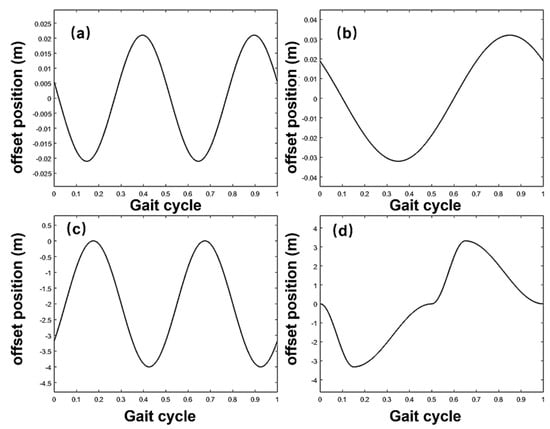
Figure 1.
Trajectory function of human walking: (a) forward/backward panning; (b) lateral translation; (c) forward/backward rotation; and (d) left/right rotation.
- (2)
- Lateral Translation
The formula below is used to describe the lateral oscillation of the center of the spine:
which
This lateral translation function is shown in Figure 1b.
- (3)
- Forward/Backward Rotation
The formula below is used to describe the flexion movement of the human back relative to the pelvis before each step of forward leg movement. This rotational motion is expressed in degrees (°) by the following formula:
which
This rotation function is shown in Figure 1c.
- (4)
- Left/Right Rotation
This formula is used to describe the flexion motion that causes the pelvis to fall to the side of the swing leg, and this rotational motion is expressed in the form of a segmented function, as follows:
where , This rotation function is shown in Figure 1d.
- (5)
- Human Walking Models
The human body model is characterized in the literature [10] in terms of 17 key joints, which include the head, neck, base of the spine, left and right shoulders, elbows, hands, hips, knees, ankles, and toes. According to the trajectory function of each part of the human body described by the biomechanical experimental data model, after correctly calculating the trajectories of each part of the human body during walking, the walking model of the human body can be constructed using these trajectories in order to calculate the positions of the 17 key joint points of the human body in the three-dimensional space. As shown in Figure 2, taking the base point of the spine as the origin, a coordinate system is established, and the positive direction is forwards, the positive direction is to the right, and the positive direction is upwards. The three-dimensional orientation of any part of the human body can be determined by the positioning of these 17 joints within the human body’s reference coordinate system. These translational and rotational kinematic parameters of the human body can be used to simulate human echoes.
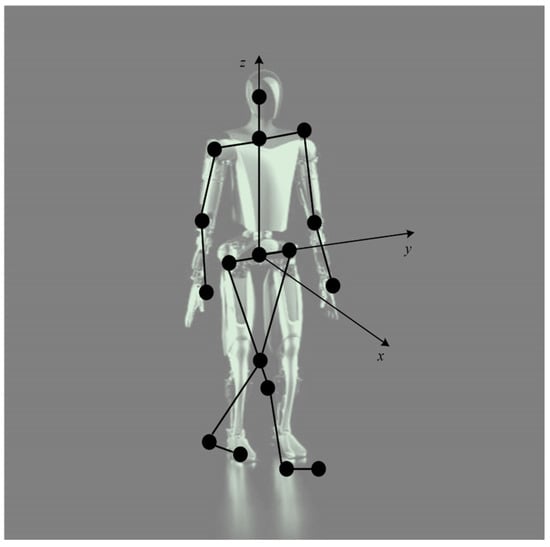
Figure 2.
Critical joints in the human body.
3. Results
3.1. Simulation Experiment Scenario Description
The entire simulation experiment scene is depicted in Figure 3. Within the room, a WiFi router (denoted as Tx) was positioned as the signal transmitter, while a signal receiver (denoted as Rx) was strategically placed to capture the transmitted signals. The transmission signal from the router Tx propagated radially from the transmission point. Upon encountering a human body, the signal underwent scattering. A portion of these scattered signals was subsequently received by the receiver Rx. The WiFi signal scattered back by the human body was treated as a wave source by the receiver. Different behavior patterns of the human body caused relative displacement changes between the wave source and the receiver, resulting in frequency changes in the scattered echo. This means that, when the human body makes a certain action under WiFi coverage, the receiver can obtain the Doppler effect changes corresponding to different behavior patterns of the human body.
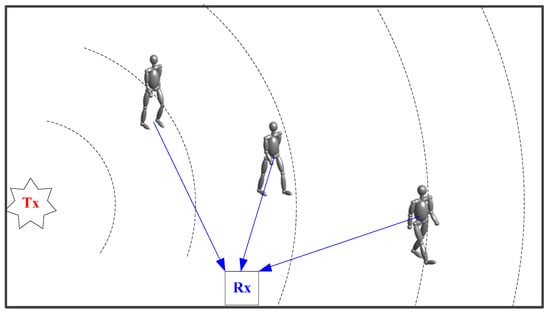
Figure 3.
Simulation experiment scenario.
This article designed two sets of simulation experiments for verification and analysis. The first group generated echo data of the human body under various behavioral patterns and analyzed the micro motion characteristic signals of various parts of the human body. The second group generated echo data of different pedestrians and analyzed the overall micro-Doppler characteristics of different pedestrians during walking.
3.2. Signal Analysis of Human Micromotor Characteristics
Relative to visual image sequences, micro-Doppler features are not sensitive to distance, lighting conditions, and background environment, and they are stable and highly separable features. With a kinematic model of human walking, it is possible to generate echo data of the human body in walking mode. Taking the typical male height and walking relative speed as an example, human body echoes are generated based on the WiFi signal. It is assumed that the fuzzy subpeaks of WiFi signals are suppressed and processed by direct wave and clutter suppression. Firstly, the signals of micromotor features [11] in different parts of the human body are analyzed.
Figure 4 shows the results of the micro-Doppler characterization of different parts of the human body. Figure 4a–d show the head, left lower arm, left lower leg, and left foot micro-Doppler features, respectively. The head micro-Doppler amplitude is the smallest, at about 50 Hz, and the micro-Doppler curve is a cosine curve, due to the fact that the human body always maintains a relatively stable state during walking. The amplitude of the left lower arm is close to 50 Hz, and the Doppler curve is a regular cosine curve. The amplitude of the left lower leg is about 70 Hz, but the Doppler curve is an irregular cosine curve. The amplitude of the foot is the largest, at about 110 Hz, and the Doppler curve is jagged, which is due to the fact that there are accelerations and decelerations in the human body in the process of walking. It can be seen that the micro-Doppler features of each part of the human body are significantly different in terms of micro-Doppler amplitude, micro-motion curve morphology, and micro-motion period, so the human body and its behaviors can be classified and identified by micro-Doppler features.
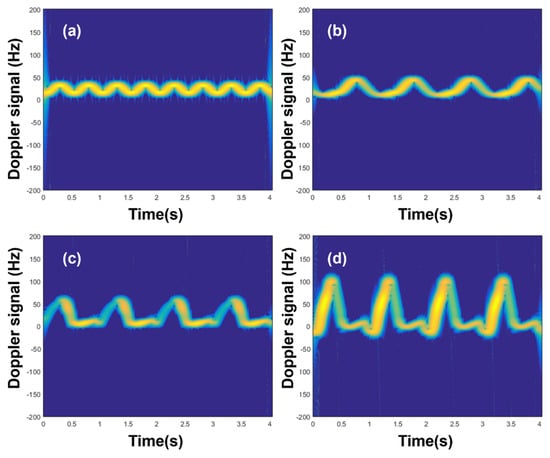
Figure 4.
Micro−Doppler characteristics of different parts of the human body, different colors represent different magnitudes of values: (a) head micro-Doppler signatures; (b) left lower arm micro-Doppler features; (c) left lower leg micro-Doppler features; and (d) left foot micro-Doppler characteristics.
The overall micro-Doppler characteristics of different pedestrians during walking are further analyzed, and the overall micro-Doppler characteristics are actually the integrated Doppler histories of each part of the human body during a given observation time. Figure 5a,b show the overall micro-Doppler characteristics of pedestrians at height and relative walking speeds of , respectively. When the walking speed increases, the maximum micro-Doppler amplitude increases accordingly, while the gait period becomes smaller, and the overall micro-Doppler characteristics of the pedestrians are more sensitive to changes in speed. Figure 5c,d show the overall micro-Doppler signatures of pedestrians at a relatively high walking speed of and heights of , respectively. When the heights are relatively high, the maximum amplitude of the micro-Doppler becomes slightly larger, and the gait cycle is closer, so the overall micro-Doppler signatures of pedestrians are less sensitive to changes in heights. Through the comparative analysis, it can be seen that the micro-Doppler features clearly portray the movement characteristics of different pedestrians and carry the characteristic information of human body movement, which further confirms that WiFi signals and the extraction of micro-Doppler features can be used to classify and identify the human body and its behaviors.
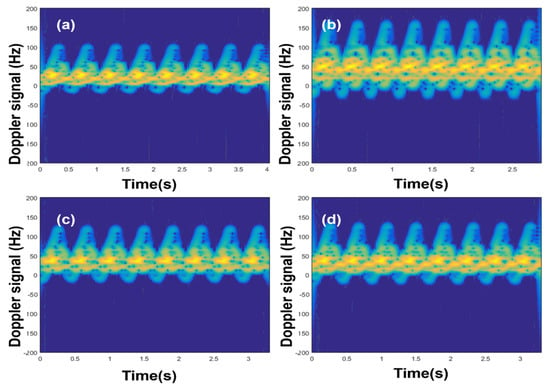
Figure 5.
Micro−Doppler characteristics of pedestrians at different heights and walking speeds, different colors represent different magnitudes of values: (a) height , relative velocity ; (b) height , relative velocity ; (c) height , relative velocity ; and (d) height , relative velocity
In order to verify the effectiveness of the human behavior recognition method based on WiFi signal, an experiment was carried out on the generated simulation data set using the deep learning method [12] (Figure 6).

Figure 6.
Deep learning method.
The training data were simulated noiseless time–frequency images, and the test data were noisy time–frequency images with a signal-to-noise ratio of 10 db. Each action contained 200 samples. Using the method of training based on fragments, each training fragment selected 1 and 5 samples of known categories for each category to form a support set and selected 20 samples from the remaining samples as a query set, with a total of 200 iterations of fragment training. The learning rate of network training was set to 0.01. After the training, 500 independent experiments were conducted during the test phase, with a total of 500 test samples.The recognition results under different few-shot recognition task settings are shown in Table 1.

Table 1.
The recognition results under different few-shot recognition task settings.
The relational network model was mainly composed of an embedded module and a relational module. Firstly, we input the support set samples of the known category label and the query set samples of the unknown category into the embedded module at the same time and generated the corresponding feature maps of the two categories, separately. Then, the feature map was input into the relation module to generate the relation score, which could represent the similarity between the support set samples and the query set samples. Finally, by comparing the relation scores, the support set sample labels corresponding to the highest scores were used as the prediction categories of the query set samples.
From the experimental results, we could see that, with the increase in the number of support set samples, the recognition rate under the small-sample task also increased, and then the generalization of the model was improved.
3.3. Comparison with Existing Human Behavior Recognition Techniques
WiFi-based human behavior recognition demonstrates distinct advantages over video- and infrared-based methods in terms of penetration capability, privacy preservation, and adaptability to diverse environments. Operating at 2.4 GHz and 5 GHz frequencies (wavelengths of 12.5 cm and 6 cm), WiFi signals exhibit strong wall-penetrating properties, enabling reliable non-line-of-sight detection in indoor settings. Unlike video systems, which rely on visible light (380–780 nm) and require direct line-of-sight, WiFi bypasses obstacles such as walls and furniture, making it ideal for cluttered or partitioned spaces. Although signal attenuation occurs with distance and physical obstructions, WiFi maintains sufficient strength for accurate behavior recognition, even in multi-room environments.
Video-based methods, while providing rich visual data, suffer from critical limitations. Their dependence on visible light renders them ineffective in low-light conditions, and background noise or illumination changes can degrade performance. Furthermore, continuous video surveillance raises significant privacy concerns due to the capture of identifiable personal information. Infrared-based approaches, leveraging thermal radiation (700 nm–1 mm), perform well in darkness but struggle with accuracy in thermally dynamic environments, as ambient temperature fluctuations and background heat sources interfere with signal interpretation.
WiFi’s superiority is evident in performance metrics. In three-way-five-shot tasks, WiFi achieved 94.0% accuracy,surpassing video human behavior recognition method based on improved 3D ResNet (75.22% accuracy on Top 5) [13] and infrared human behavior recognition method based on multimodal attention network(93.11% accuracy) [14]. These results are summarized in Table 2. WiFi’s ability to analyze subtle signal variations, such as Doppler shifts and channel state information (CSI) perturbations, contributes to its high performance. Additionally, WiFi systems consume less power and require less dense sensor deployment, reducing operational costs.

Table 2.
Performance comparison of different human behavior recognition techniques.
A key advantage of WiFi is its robustness across scenarios. Testing in varied room sizes, layouts, and clutter levels confirmed consistent accuracy for behaviors like walking, running, jumping, sitting, and standing. Unlike infrared systems, which falter under thermal interference, WiFi remains unaffected by ambient temperature, ensuring stable performance in environments with HVAC systems or fluctuating heat sources. Its compatibility with existing infrastructure (e.g., routers) further simplifies deployment, avoiding the need for dedicated hardware.
In terms of privacy and ethics, this study did not involve any experiments on biological entities or human subjects, ensuring that no personal data or sensitive information would be collected or compromised. This approach inherently avoided potential ethical issues related to human participation and data privacy concerns.
In summary, WiFi excels as a versatile, cost-effective solution for indoor behavior recognition, combining high accuracy, environmental adaptability, and privacy preservation. Its non-invasive nature, compatibility with existing networks, and resilience to lighting or thermal challenges position it as a superior alternative to traditional methods in real-world applications where practicality and ethics are paramount.
4. Discussion and Conclusions
WiFi signals are very suitable to be used for passive detection due to their wide popularity, no electromagnetic pollution, and spike-like signal blur function after subpeak suppression. Starting from target detection based on WiFi signals, the current paper further expanded its application and explored the feasibility of its application to human behavior recognition. Firstly, the characteristics of typical WiFi signals were elaborated, a parametric mathematical model of human walking was established, and several common typical translational and rotational motion functions were analyzed. Finally, according to the human kinematic model, echo data of the human body in various behavioral modes were generated, the micro-Doppler features of human body parts and the whole body were analyzed, and the results confirmed the feasibility of human behavior recognition based on WiFi signals and the extraction of micro-Doppler features.
In conclusion, this study provided a thorough exploration of human behavior recognition based on WiFi signals, highlighting its potential as a versatile and privacy-preserving solution. The core technique of this study involved utilizing WiFi signals to capture micro-Doppler signatures, unique to different behaviors and body movements. By developing a detailed parametric mathematical model of human walking, we successfully simulated and analyzed the corresponding echo data for various behaviors, thereby extracting discriminative features for behavior recognition. This approach not only demonstrated high accuracy and robustness across diverse environments but also ensured privacy protection by avoiding the use of visual or thermal imaging techniques. Future research will aim to further enhance the robustness and accuracy of the system, explore practical application scenarios, and address potential challenges in varied environments.
Author Contributions
Conceptualization, L.L.; methodology, P.C.; software, L.L.; investigation, P.C. and Y.W.; data curation, P.C. and L.L.; writing—original draft, L.L.; writing—review and editing, Y.W.; visualization L.L.; and supervision, P.C. All authors have read and agreed to the published version of the manuscript.
Funding
This research received no external funding.
Institutional Review Board Statement
Not applicable.
Informed Consent Statement
Not applicable.
Data Availability Statement
All data generated or analyzed during this study are included in this published article. The code and trained weights can be provided upon request.
Conflicts of Interest
The authors declare no conflicts of interest.
References
- Chetty, K.; Smith, G.E.; Woodbridge, K. Through-the-wall sensing of personnel using passive bistatic WiFi radar at standoff distance. IEEE Trans. Geosci. Remote Sens. 2012, 50, 1218–1226. [Google Scholar] [CrossRef]
- Rao, Y.; Pan, D.; Zhu, H.; Wang, X.; Yi, J.; Gong, Z.; Ke, H. Single station localization of indoor WiFi emitter with multipath exploitation. J. Terahertz Sci. Electron. Inf. Technol. 2021, 19, 672–677. [Google Scholar]
- Wu, X. Research on WiFi-Based Passive Radar Waveform and Key Technologies of Signal Processing; University of Electronic Science and Technology of China: Cheng Du, China, 2019. [Google Scholar]
- Rao, Y.; Ming, Y.; Lin, J.; Zhu, F.; Wan, X.; Gong, Z. Reference Signal Reconstruction and Its Impact on Detection Performance of WiFi-based Passive Radar. J. Radars 2016, 5, 284–292. [Google Scholar]
- Kumawat, S.; Verma, M.; Nakashima, Y.; Raman, S. Depthwise spatio-temporal STFT convolutional neural networks for human action recognition. IEEE Trans Pattern Anal. Mach. Intell. 2021, 44, 4839–4851. [Google Scholar] [CrossRef] [PubMed]
- Li, C.; Xie, C.; Zhang, B.; Han, J.; Zhen, X.; Chen, J. Memory attention networks for skeleton-based action recognition. IEEE Trans Neural Netw. Learn. Syst. 2021, 33, 4800–4814. [Google Scholar] [CrossRef] [PubMed]
- Hao, X.; Li, J.; Guo, Y.; Jiang, T.; Yu, M. Hypergraph neural network for skeleton-based action recognition. IEEE Trans Image Process. 2021, 30, 2263–2275. [Google Scholar] [CrossRef] [PubMed]
- Yang, W. IEEE 802.11 WLAN Standard Developing Process and Developing Direction. Telecom Eng. Tech. Stand. 2002, 54, 59. [Google Scholar]
- Boulic, R.N. Magnenat-Thalmann, and D. Thalmann. A Global Human Walking Model with Real-Time Kinematic Personifi cation. Vis. Comput. 1990, 6, 344–358. [Google Scholar] [CrossRef]
- Chen, V.C. The Micro-Doppler Effect in Radar; Wu, S.; Du, L.; Liu, H., Translators; Publishing House of Electronics Industry: Beijing, China, 2013; pp. 149–159. [Google Scholar]
- Chen, V.C. Analysis of radar micro-Doppler with time-frequency transform. In Proceedings of the Tenth IEEE Workshop on Statistical Signal and Array Processing (Cat. No.00TH8496), Pocono Manor, PA, USA, 16 August 2000; pp. 463–466. [Google Scholar]
- Guo, J.; Wang, L.; Zhu, D.; Zhang, G. SAR target recognition with limited samples based on meta knowledge transferring using relation network. In Proceedings of the 2020 International Symposium on Antennas and Propagation (ISAP), Singapore, 4–10 December 2021; pp. 377–378. [Google Scholar]
- Niu, W.; Zhai, R. A video human behavior recognitionmethod based on improved 3D ResNet. J. Comput. Eng. Sci. 2023, 45, 1814–1821. [Google Scholar]
- Wang, C.; Tang, C.; Wang, W.; Zhang, J. Infrared Human Action Recognition Method Based on Multimodal Attention Network. J. Comput. Sci. 2024, 51, 232–241. [Google Scholar]
Disclaimer/Publisher’s Note: The statements, opinions and data contained in all publications are solely those of the individual author(s) and contributor(s) and not of MDPI and/or the editor(s). MDPI and/or the editor(s) disclaim responsibility for any injury to people or property resulting from any ideas, methods, instructions or products referred to in the content. |
© 2025 by the authors. Licensee MDPI, Basel, Switzerland. This article is an open access article distributed under the terms and conditions of the Creative Commons Attribution (CC BY) license (https://creativecommons.org/licenses/by/4.0/).